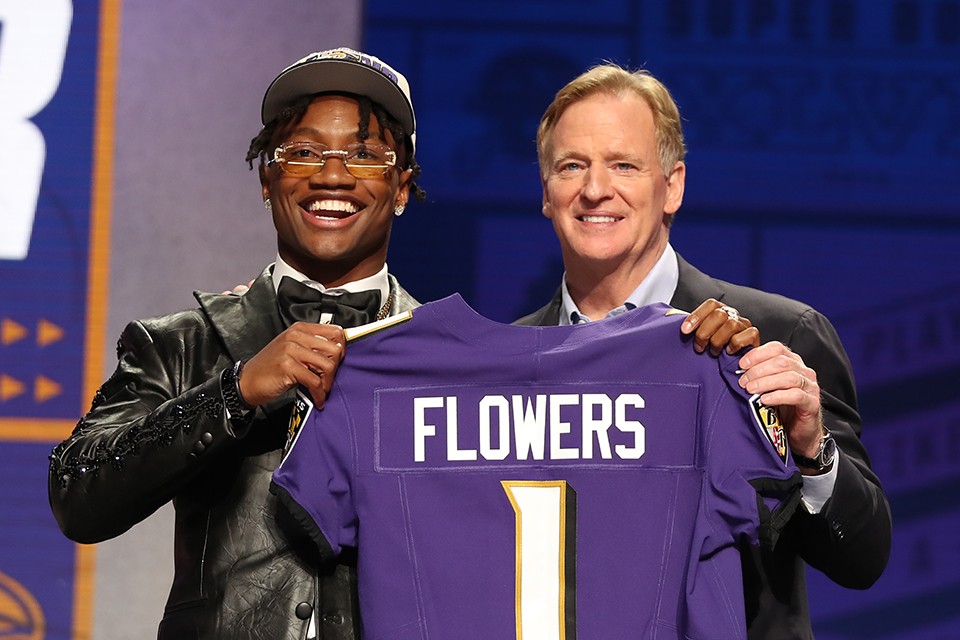When Scott Mutryn and three of his buddies heard the news last summer that other colleges were trying to lure away their alma mater’s star wide receiver, Zay Flowers, they knew they had to do something. And fast. Mutryn and his friends didn’t work for BC Athletics—or for the college at all—so they couldn’t offer Flowers anything more than the free tuition he was already receiving from the school as a scholar-athlete. They weren’t Flowers’s classmates, much less his teammates, so they couldn’t exactly peer pressure him into staying, either. Instead, Mutryn, Joe Popolo, Samuel Raia, and Brian Tusa were merely Boston College alums who now work in finance or business and care deeply about their school’s sports teams. And in today’s world of college athletics, it turns out, they are precisely the kinds of guys who can help get a top player like Flowers to stay put.
That’s because these days, being a college athlete at a Division I school is nothing like it used to be. Not even close. Since the dawn of sporting time, college athletes have been forbidden from making money for playing for their team, be it from product endorsements or having their likeness appear in a video game. All of that changed in 2021 when, under intense pressure from players and in response to lawsuits lost and new laws passed in several states, the National Collegiate Athletic Association (NCAA) changed its age-old policy, allowing athletes to use their “name, image, or likeness,” known as NIL, for profit. And practically overnight, everything everywhere transformed all at once.
Knowing the new rules, Mutryn and his BC friends did what many others across the country have done and formed what is now known as an “NIL collective,” BC’s first. These entities—essentially newly legitimized booster clubs—can arrange sponsorship deals for players, set up autograph sessions at places like Chipotle or charity functions, and cut checks. Their objective is to use alumni donations and lucrative sponsorship deals to lure or to retain athletes at colleges that the collective supports but from which it remains independent. Today, by some estimates, there are nearly 200 collectives nationwide.

Former Boston College quarterback Scott Mutryn—pictured here in a November 1998 home game against the Notre Dame Fighting Irish—started BC’s first NIL collective with three friends. / Photo by Ezra O. Shaw / Allsport via Getty Images
BC was relatively late to the party. “The college didn’t have one until us,” says Mutryn, a former BC quarterback who was signed by the Pats but didn’t make the cut on the 1999 squad. “What got us going was the talk of Zay Flowers transferring.” They formed the Friends of the Heights collective and quickly helped secure Flowers a tidy NIL portfolio of deals, including a brand-new BMW worth $90,000 and a Dunkin’ endorsement. This was small change compared to enticements offered by other NIL companies—as much as $600,000 if he transferred—but Flowers decided to stay at BC.
Beyond the Flowers case, all of this change over the past year has created a lot of buzz around town about what this new era in college sports could signify for our teams, particularly our big-time Division I program up on Chestnut Hill. Might it mean the BC football team could return to its glory days when Doug Flutie was a household name coast-to-coast? Does it mean the college has a shot once again of fielding a men’s basketball team that makes a championship run during March Madness? Could giving cold, hard cash to collegiate players ever make Boston not just a crazy-good sports town but a crazy-good college sports town, too?
The smart answer appears to be: Don’t place that bet. In fact, if trends continue to evolve toward greater rights and riches for university athletes, local college sports fans may find themselves even farther from that pipe dream than they are today.

Boston College’s Zay Flowers in March 03, 2023 in Indianapolis, Indiana. (Photo by Michael Hickey/Getty Images)
From its sweetly innocent inception in 1906, the Intercollegiate Athletic Association (precursor to the NCAA) preached the purity of the unpaid, letter-sweatered student-athlete—an all-American crewcut lad (no lassies under NCAA dominion until the early 1980s) with a book in one hand, a ball in the other, and clear eyes, a full heart, and a love for amateur competition. Soon, though, questions arose: Was the boy really going to class? Was he on the take? So-called booster clubs in support of the local college team gained deserved reputations as fat-cat-run alum organizations that beguiled hot-shot prospects with filthy lucre, no-show jobs, and even sex. In response to these and other worse scandals, such as gangster-goaded point-shaving, the NCAA issued a “Sanity Code”—real name!—in 1948. The association enforced its scholar-athlete rules with a vengeance.
Then came TV. In the 1950s, big-dollar TV contracts for the rights to air the games granted schools the ability to print money for themselves and their employees, which did not include the athletes. Enormous checks from media companies filled the coffers of the NCAA, the colleges, the leagues, athletic directors, and coaches. Look at where it’s gotten to: Rights for basketball’s March Madness is now worth more than a billion dollars a year. Big Ten football’s TV deal, beginning this fall, is also worth a billion bucks per season. BC wanted a piece of that action, so in 2003 it announced it was taking its profit-making men’s football team to the hyper-competitive Atlantic Coast Conference (ACC), securing what has since grown into a $36 million slice of that league’s annual pie. All the while, as schools raked in more money, players were told they were still student-athletes. Their sole recompense was a full or partial tuition scholarship plus room and board.
Athletes were wising up and lawyering up before COVID hit, but what the NCAA allowed during the pandemic fully exposed the depth of its cynicism, hypocrisy, and greed. While student-students were instructed to continue classes remotely, even after the first wave of the pandemic passed, student-athletes—their school’s TV money at stake—were summoned back to neutron-bombed campuses to play games in “a bubble.” Fans in the stands were cardboard cutouts. Contests were canceled when illness swept through locker rooms. In 2020, BC’s football players opted to refuse an invitation to a postseason bowl game over COVID concerns. This wasn’t exactly the Boston Tea Party, but it was something new.
Also new and more consequential was California’s Fair Pay to Play Act, a state statute that went into effect in September 2021 forbidding the NCAA from punishing any student-athletes who traded on his or her name, image, or likeness. Suddenly, players could sign contracts with Nike or peddle merch with personal branding. Other state legislatures, fearing a gold-rush-like exodus of their college sports stars to the Golden State, followed California’s lead. And then, in a huge moment for college players all over the country, the U.S. Supreme Court ruled in 2021 that the NCAA couldn’t stymie payments to athletes. “Nowhere else in America,” wrote Justice Brett Kavanaugh, in his concurrence to a unanimous decision, “can businesses get away with agreeing not to pay their workers a fair market rate…. The NCAA is not above the law.”
In no time, the NCAA raced to concoct NIL “guidance” that freed athletes to pursue their fortunes. It also gave license to ordinary citizens—fans—to come up with fresh ideas like NIL collectives to support their teams. These new ideas came, just like Division I defensive linemen, in as many different shapes, sizes, and ethical behaviors as you can imagine. “It’s the Wild West out there,” says Ivan Maisel of the sports media outlet On3, who has been writing about college football for 40 years and has never seen anything like this. “Coaches are pissed at one another for poaching. Recruits are asking, ‘What’re ya gonna pay me?’ Everyone’s wondering, ‘What’s next?’”
Around Boston, fans began wondering what might be next for the closest thing the city has to big-time men’s basketball, hockey, and football programs: BC.

Star BC lacrosse player Belle Smith has an estimated income of $18,400. / Photo by Isaiah Vazquez/Getty Images
To understand why little will likely change at BC in this new era requires context. The most valuable male athlete, 18-year-old high school basketball player Bronny James, NBA superstar LeBron James’s son, now has deals with Nike and others and an estimated take in 2023 of $7.2 million. The most-valuable woman, ranked third overall in college sports, is LSU gymnast Livvy Dunne, at $3.4 million. A terrific athlete, she’s rich due to her social media celebrity—more than 360 million likes on TikTok—and has scored a contract with the clothing line Vuori. Meanwhile, a collective at the University of Tennessee, for instance, says it hopes to shell out some $25 million this year to retain or recruit players.
Compare that to BC, where the top-earning athlete is football defensive end Donovan Ezeiruaku at $618,000. Star BC lacrosse player Belle Smith, one of the best in the nation, has an estimated income of $18,400. Meanwhile, the Friends of the Heights collective has about $1 million in assets that it has raised from alumni donors. “We can’t compete on that level, and we’re not trying to,” says Mutryn of big-time football schools like Tennessee and Clemson. “We’re not into recruiting high school kids at all. We’re focused on helping to retain athletes who’ve already chosen BC. That’s what Zay Flowers was.”
Flowers’s circumstance says a lot about where this is all going. When he started hearing from collectives associated with other schools, he received offers for NIL deals as large as $600,000 if he transferred from BC. “For a kid like me from a household of 14 with one parent, that’s life-changing money,” Flowers told ESPN at the time. The deal he got at BC was nothing like that, yet he chose it for another reason. “The BC degree is a lot more valuable,” he has said. “I can make more than $600,000 with my degree and the alumni network down the road.” He doesn’t have to wait for “down the road,” because the NFL loved him plenty at last month’s draft, and he’s now all set to be a multimillionaire pro football player.

Zay Flowers and NFL Commissioner Roger Goodell, after the Baltimore Ravens selected the BC player 22nd overall during the 2023 NFL Draft’s first round. / Photo by David Eulitt/Getty Images
Other Massachusetts college players are also getting theirs in the current free-for-all, and the Dodge City that is NIL certainly can be amusing. Case in point: Amherst College football player Jack Betts, a pass-catcher for a last-place NESCAC team who is known as the King of D-III NIL, has managed to persuade three dozen companies, including Omaha Steaks and a massage-gun maker, to pay him in product.
This may be only a brief moment in college sports history, but with the TikTok gymnast superstar and our own massage-gun hero, it’s a wacky one. And in the end, the notion of paying athletes may lead to precisely the opposite changes at BC than fans might be hoping for.
Akin to the sporting Yogism that it ain’t over till it’s over, the future is the NCAA’s worst nightmare: one in which colleges put their athletes on the school payroll. This could come sooner than later. In Johnson v. NCAA, before the U.S. Third Circuit Court in Philadelphia at presstime, former Villanova football player Trey Johnson, citing the 1938 Fair Labor Standards Act, claims Division I athletes should be paid by schools, which are clearly involved in a profit-making venture. The NCAA has failed to get the case dismissed so far. Justice Kavanaugh & Co. await in their Marble Palace.
Whatever happens, NILs are here for good. Collectives, though, might vanish as quickly as they were formed, because if schools have to pay their athletes Kavanaugh’s “fair market rate” in a hot market, what need is there for collectives to leave a tip? “Revenue sharing between schools and athletes is inevitable,” says Jay Paterno, who played at Penn State during the 1980s, coached at various schools for 22 years, and is now a trustee of his alma mater. He formed one of the nation’s first collectives but thinks it has a sell-by date. “Collectives could be history,” he has said. “Alumni could go back to contributing to the school library. That would not be a bad thing.” Courtney Altemus, a former Wall Street exec who founded TeamAltemus in 2017 to educate athletes and schools in financial literacy, agrees: “There’s no clear and fair end until [profit sharing] happens. Kavanaugh has made it abundantly clear…. The players are the labor. Even [new NCAA head Charlie Baker] will have trouble arguing against that.”
On March 1, Massachusetts’ former governor, Charlie Baker, sidled into his new gig as president of the NCAA. Tellingly, he is not stationed at the organization’s headquarters in Indianapolis but in Washington, DC, where he can lobby legislators who speak his political language. At the top of his agenda will be the matter of paying athletes—and no one is predicting he will have much success reversing the tide. After making the rounds with Congress and when the courts have had their final say, Baker will likely survey the wreckage and coax his organization to let go of the past and, it is hoped, forge a more sensible future. A first question of his constituents—the schools—should be: What do you truly want, and can you ever stop thinking about the money?
That is a question BC should be asking itself right now. For years, its athletes happily played against comparable schools, until it left for the TV money and ACC bullyboys like NC State and Clemson. It’s rarely been able to compete with the many teams it now plays against. But with so much money now incentivizing players, will BC’s trustees be willing to start paying millions to athletes instead of funding other things the school does so well, including academics? Or will it want to be more like Harvard, a Division I school that plays in a non-money-making conference yet strives as much as possible to preserve a vestigial scholar-athlete mold?
On3’s Maisel dreams of a tomorrow in which university overlords finally look at themselves in the mirror. “Sure, the biggest programs—Alabama, Georgia, Clemson, Texas—will just pay big-time for the best athletes,” he says, “but what might be interesting is mid-level schools with a traditional college scholar-athlete ideal. BC’s one. Does BC want to be in a bidding war in the ACC against the nutcases at Clemson? Or do they maybe try to find some kind of Ivy League balance elsewhere? Maybe new leagues form. Maybe BC, Northwestern, Stanford, and Notre Dame play each other in a new league. Maybe they take a step back.”
Maybe.


